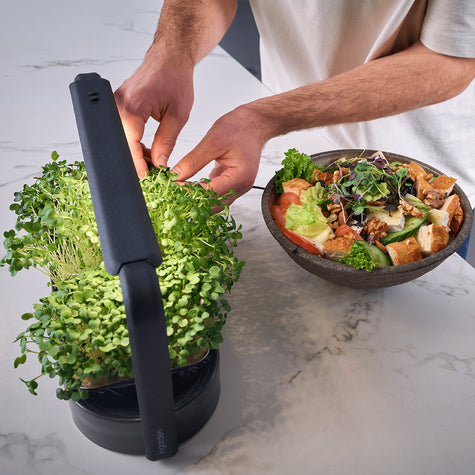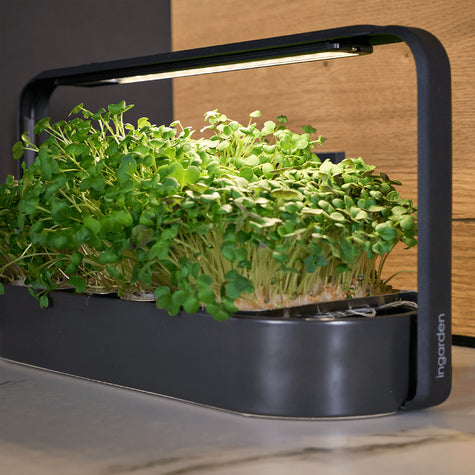Welcome, dear animal lovers and green enthusiasts, to our ingarden blog! Today we embark on a journey that unites the worlds of nutrition and canine companionship by exploring the incredible benefits of incorporating microgreens into your furry friend's diet.
As a team of microgreens and dog lovers, I'm excited to share with you the secrets of these tiny, vibrant vegetables and their potential to enrich the lives of our beloved dogs. In this guide, we'll uncover the wonders of microgreens, understand their nutritional value, and discuss the safety aspects of feeding microgreens to your four-legged companions.
Microgreens aren't your typical greens; they're the tender, edible shoots of young plants, packed with concentrated nutrients and delicious flavors. Unlike sprouts, which are harvested earlier, and mature vegetables, microgreens are picked at an intermediate stage of growth, achieving a perfect balance between flavor and nutritional content.
But that's not all: We'll also highlight the numerous health benefits that microgreens offer our furry friends. From boosting the immune system to improving skin and coat health, these tiny greens are a true powerhouse of nutrients.
We know that as a pet owner, you may have some concerns and questions about the safety and effectiveness of microgreens for dogs. Don't worry, we'll address common concerns, discuss potential side effects, and emphasize the importance of consulting your veterinarian for personalized advice.
Before you rush into adding microgreens to your dog's food bowl, we'll guide you through the process of incorporating them safely and effectively. Whether you're considering adding them to commercial dog food or preparing healthy, homemade meals, we've got you covered.
As responsible pet owners, we know how important it is to ensure our dogs' well-being. Therefore, we will explore the pros and cons of feeding microgreens to dogs and help you make informed decisions about their nutritional needs.
For those with a green thumb and a passion for growing their own food, we have exciting tips for growing pet-friendly microgreens. Together, we'll discover the best microgreens you can grow for your furry friends and discuss the importance of organic and pet-friendly growing methods.
Finally, we invite you to join us on this captivating journey of discovery into microgreens for dogs. By the end of this guide, you'll be equipped with the knowledge and confidence to offer your furry companions this nutrient-rich greenery, thereby promoting their overall health and happiness. So let's embark on this green adventure together and unlock the potential of microgreens for our four-legged friends! 🐾🌱
Understanding Microgreens
Microgreens are young, edible greens harvested at an early stage of growth, typically around 7 to 21 days after germination. These tiny plants are characterized by their vibrant colors and distinctive flavors, ranging from mild to intensely aromatic. Common microgreens include broccoli, kale, mustard greens, radishes, and sunflower sprouts. These mini greens contain many essential nutrients and are therefore an ideal addition to any dog's diet.
Microgreens, sprouts and fully grown greens all belong to the same plant family, but are harvested at different stages of development:
- Microgreens : As mentioned previously, microgreens are harvested after the first set of true leaves has developed, but before they reach full maturity. This unique stage offers a concentrated boost of nutrients, making them particularly beneficial for dogs.
- Sprouts : Sprouts are even younger than microgreens and are harvested just a few days after germination, usually before they develop leaves. They are typically grown in water and are more susceptible to bacterial contamination, which poses a potential health risk to dogs.
- Mature vegetables : These are the mature versions of plants like kale, spinach, or lettuce that you may already be familiar with. While whole greens still offer health benefits, they don't have the high nutrient density of microgreens.
Nutritional value
Microgreens boast an impressive nutritional profile, packing a considerable punch into a small package. Studies have shown that these miniature vegetables can contain up to 40 times more nutrients than their mature counterparts. Some of the key nutrients found in microgreens include:
- Vitamins : Microgreens are rich in vitamins A, C, E and K, which all play an important role in supporting your dog's immune system, eyesight and overall health.
- Minerals : This green vegetable is rich in important minerals such as potassium, calcium, iron and magnesium, which promote strong bones and support various bodily functions.
- Antioxidants : Microgreens are rich in antioxidants such as beta-carotene and lutein, which fight harmful free radicals and protect your dog's cells from oxidative stress.
- Dietary fiber : The presence of dietary fiber in microgreens supports the healthy digestion of your furry companion.
With this newly acquired knowledge about the unique properties of microgreens, we can now examine more closely their safety for consumption by dogs and uncover the health benefits for our four-legged friends.
The safety aspect: Are microgreens safe for dogs?
As responsible pet owners, the safety of our furry friends is of utmost importance. Before introducing a new food into your dog's diet, you should definitely consider their well-being.
Microgreens are generally safe for dogs, but as with any new food, it's important to introduce them gradually and watch for any adverse reactions. While microgreens are rich in nutrients, moderation is key to a balanced diet for your pet. It's also advisable to avoid commercially available microgreens, which may have been treated with pesticides or other chemicals that could be harmful to your dog's health .
Known microgreens that are safe for dogs
To ensure the safety of your furry companion, here are some microgreens that are known to be safe for dogs to eat:
- Broccoli microgreens : Broccoli is rich in vitamins A, C, and K, as well as antioxidants, and can support your dog's immune system and overall health. They also contain sulforaphane, a compound known for its potential anti-cancer properties.
- Kale microgreens : Kale is a nutritional powerhouse, providing vitamins A, C, and K, as well as minerals like calcium and iron. They promote healthy bones, improve eyesight, and contribute to better skin and coat health.
- Sunflower sprouts : Sunflower sprouts are rich in vitamin E, an antioxidant that protects cells from damage. They also offer a mild, nutty flavor that dogs enjoy.
- Radish microgreens : Radish microgreens are a good source of vitamin C and fiber. They can support digestive health and offer a peppery flavor that makes your dog's meal more exciting.
- Spinach microgreens : Spinach is known for its iron content, which can help prevent anemia in dogs. The vitamins A and K it contains also contribute to a healthy immune system and good blood clotting.
It's important to note that while the microgreens mentioned above are generally considered safe, some dogs may be sensitive or allergic. Always monitor your dog's reaction to new foods and consult your veterinarian if you have any concerns.
Now that we have ensured the safety of microgreens for dogs, it is time to look at the most important dos and don'ts when feeding microgreens to dogs.
Microgreens: Dos and Don'ts for Dogs
Feeding your dog microgreens can be a wonderful experience, but it's important to do so with caution and care. To ensure your furry companion can fully enjoy the benefits of this nutrient-rich vegetable without potential risks, here are some important dos and don'ts to keep in mind:
Safe and appropriate quantities
- Do : Start with small amounts of microgreens and gradually increase the quantity once your dog has become accustomed to them. Moderation is important, as excessive consumption can lead to digestive upset.
- Do : Consider your dog's size and individual health needs. Larger dogs may be able to tolerate slightly larger portions of microgreens than smaller breeds.
- Don't : Don't overwhelm your dog with too many microgreens at once, especially if they've never eaten them before. An abrupt change in diet can lead to stomach upset.
Potential allergens and how to identify them
- Do : Observe your dog for signs of allergies or adverse reactions after introducing microgreens. Symptoms may include itching, rashes, vomiting, or diarrhea.
- Do : If your dog has a history of food allergies, consult your veterinarian before introducing new foods such as microgreens.
- Don't : Ignore any signs of allergies. If you suspect your dog is having a negative reaction to microgreens, stop feeding them immediately and consult a veterinarian.
Avoid toxic microgreens
- Do : Be careful and avoid feeding your dog microgreens from plants that are known to be toxic to dogs, such as certain types of onions, garlic, or chives.
- Don't : Experiment with unknown vegetables without first making sure they are suitable for dogs.
Remember that every dog is unique and tolerates new foods differently. While many dogs can eat microgreens without any problems, some dogs are sensitive or allergic to them. Always be careful when introducing new foods into your dog's diet and carefully observe how your dog reacts.
Common concerns
As responsible pet owners, it's natural to have concerns and questions about the safety and effectiveness of new foods like microgreens in your dog's diet. Let's address some common concerns and offer valuable insights to ensure a smooth and safe experience for you and your beloved furry companion:
Possible side effects
- Gastrointestinal upset : Introducing new foods, including microgreens, can sometimes cause mild gastrointestinal upset in some dogs. Symptoms may include gas, loose stools, or temporary changes in bowel movements. Start with small amounts and gradually increase the quantity to minimize these effects.
- Allergies : Although rare, some dogs may have sensitivities or allergies to certain types of microgreens. Carefully monitor your dog for signs of allergies such as itching, rashes, or digestive upset, and discontinue feeding microgreens if such reactions occur.
Consultation with a veterinarian
- Individual health needs : Every dog has unique health requirements, and what works well for one may not be suitable for another. Before adding microgreens to your dog's diet, consult your veterinarian to ensure they are appropriate for your furry friend's specific health needs.
- Age and health : Puppies, senior dogs, and dogs with certain health issues may require different dietary considerations. Your veterinarian can provide individualized advice on how to incorporate microgreens into your dog's diet based on age, breed, size, and any existing health conditions.
The importance of a balanced diet
- Nutritional supplement : Microgreens are a fantastic addition to your dog's diet, but should not replace essential components of a balanced meal. Ensure that the main components of their diet consist of high-quality, balanced dog food.
- Variety : Just like humans, dogs also benefit from a varied diet. In addition to microgreens, you should also consider other healthy foods to provide a diverse nutritional profile.
Quantity and moderation
- Portion size : The appropriate portion of microgreens for your dog depends on its size, age, and individual nutritional needs. Start with a small amount and observe how your dog reacts before adjusting the quantity accordingly.
- Moderation is key : While microgreens are nutrient-rich, excessive consumption can lead to an imbalance in your dog's diet. Offer microgreens as an occasional treat or as a supplement to their regular meals, rather than using them as their main food source.
By being proactive and informed, you can provide your dog with the best possible care, including addressing their nutritional needs. Remember that every dog is unique, and what works for one may not be suitable for another. Always listen to your dog's signals and consult your veterinarian if you have any concerns or questions about feeding your furry friend microgreens or any other new foods.
Health benefits of microgreens for dogs
Microgreens may be small, but they pack a punch when it comes to nutritional value. These nutrient-rich greens offer a range of health benefits that can improve your dog's overall well-being. Let's explore the various ways microgreens can positively impact your furry friend's health.
- Strengthening the immune system : The immune-boosting properties of microgreens can strengthen your dog's immune system and better protect him against diseases and infections.
- Digestive health : The fiber content in microgreens contributes to maintaining healthy digestion and reduces the risk of digestive problems such as constipation or diarrhea.
- Joint and bone health : Microgreens, which are rich in vitamins and minerals such as calcium and vitamin K, can contribute to strong bones and joints, especially for puppies and older dogs.
- Improved skin and coat : The vitamins and antioxidants contained in microgreens can contribute to healthier skin and a shiny, glossy coat for your furry friend.
Now that we understand the remarkable health benefits of microgreens for dogs, the next step is to learn how to safely incorporate these nutrient-rich greens into your meals.
Integrate microgreens into regular meals
- Mixing with commercial dog food: If you prefer to feed commercial dog food, adding microgreens can be a simple and effective way to boost its nutritional value. Finely chop or puree the microgreens and mix them into your dog's regular food. Start with a small amount and gradually increase it as your dog gets used to the taste.
- Preparing homemade meals with microgreens : For those who enjoy preparing homemade meals for their dogs, microgreens can be an exciting addition to their culinary creations. Add microgreens to recipes for dog-friendly dishes such as stews, omelets, or even homemade dog treats.
Grow your own microgreens for your furry companion
For pet owners with a green thumb, growing your own microgreens can be a rewarding experience. This ensures that the greens are fresh, organic, and free of harmful chemicals. You can easily grow microgreens indoors or in a small outdoor space.
- Choose organic and pet-friendly growing methods : Use organic seeds and growing medium to avoid potential exposure to harmful chemicals. It's also important to keep the growing area pet-safe to ensure your furry friend doesn't have access to toxic substances.
- Proper care and handling of microgreens : Follow the specific growing instructions for each type of microgreen and ensure you receive the correct amount of water, sunlight, and ventilation. Harvest the microgreens at the right time, when they have developed their true leaves but are not yet fully mature.
By growing pet-friendly microgreens at home, you have complete control over the quality and safety of the greens you give your furry companion. The process is not only fulfilling but also helps reduce your carbon footprint and contributes to a greener and healthier environment for both you and your dog.
Conclusion
In our quest to provide the best care for our beloved canine companions, we've explored the incredible world of microgreens and discovered their potential to enhance the health and happiness of our furry friends. From understanding the difference between microgreens and sprouts to discovering their rich nutritional value, we've immersed ourselves in the wonders of these tiny green plants.
Microgreens, with their concentrated nutrients and delicious aromas, offer numerous health benefits for dogs. From boosting their immune system and promoting healthy digestion to supporting strong bones and improving skin and coat health, these green plants are true nutritional powerhouses.
By following the important dos and don'ts, you can safely introduce microgreens into your dog's diet and enjoy the satisfaction of contributing to their well-being. Start with small amounts, be aware of any potential allergies, and ensure your dog receives a balanced diet – this will make the experience harmonious and beneficial to their health.
For those with a green thumb, growing pet-friendly microgreens at home offers a rewarding way to serve your furry companions the freshest and safest greens. Using organic seeds and pet-friendly growing methods, you can cultivate an abundant supply of these nutrient-rich greens right in your own space.
Enhancing your dog's treats with microgreens not only improves their nutritional value but also adds a variety of delicious flavors to their culinary experience.
Remember that every dog is unique and individual health needs can vary. Before making any significant changes to your dog's diet, consult your veterinarian for personalized advice and recommendations.
Thank you so much for joining us on this green adventure!
Here's to a vibrant, joyful life for you and your furry friend, filled with the wonders of microgreens! 🐾🌱







